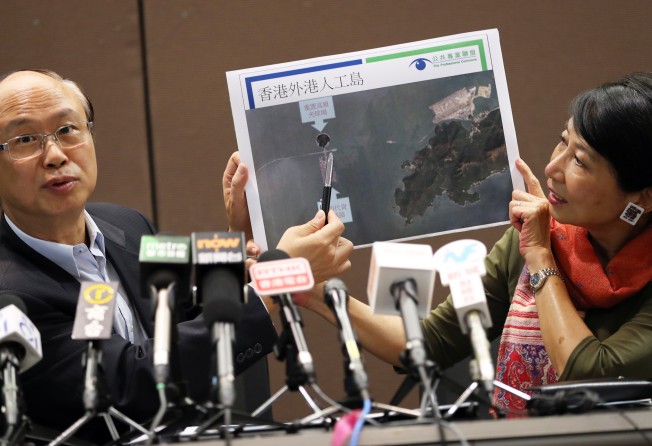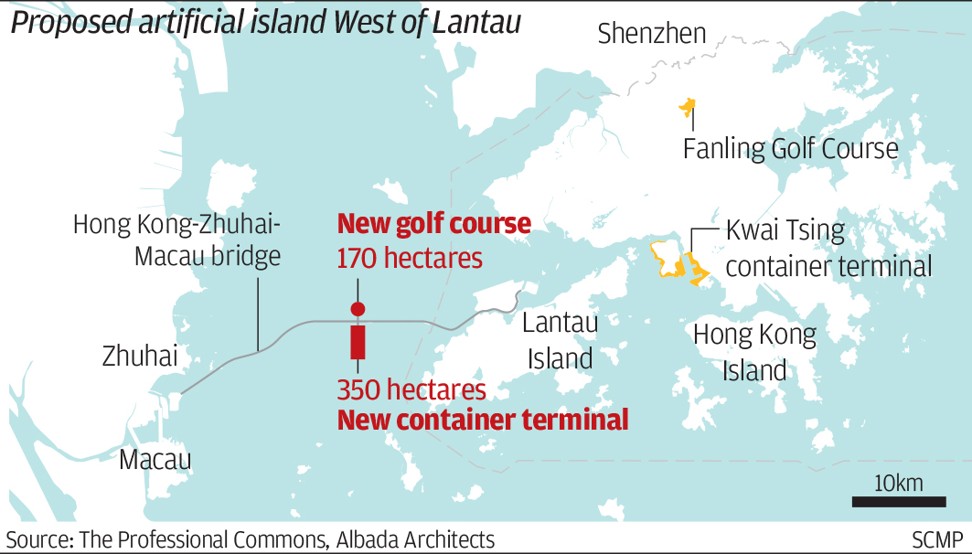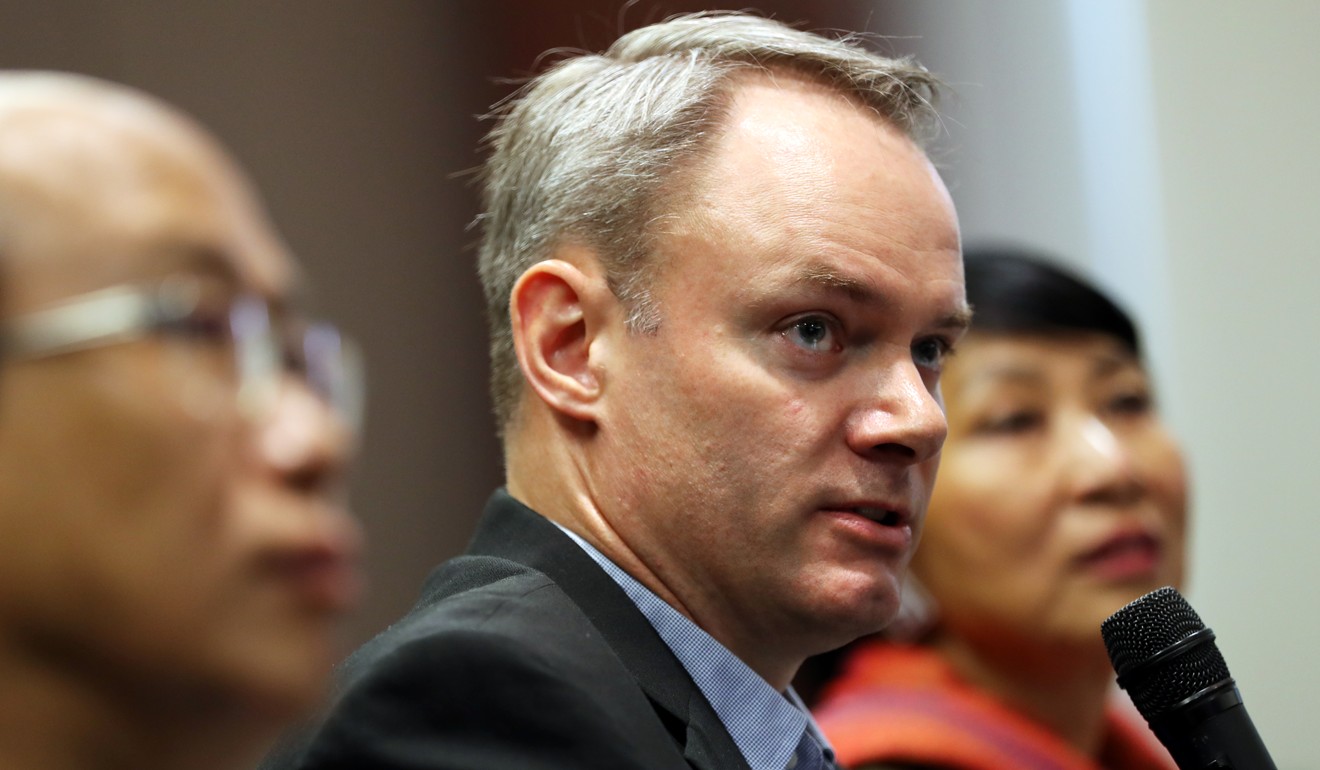Artificial island near mega bridge project could make room for 830,000 Hongkongers, think tank claims
Professional Commons suggests moving Hong Kong’s Kwai Tsing container terminal and Fanling Golf Course to new island, freeing up space in the city

Building an artificial island along the mega bridge linking Hong Kong to Zhuhai and Macau could free up space in central Hong Kong to house up to 830,000 people, a think tank has proposed.
Professional Commons, a group comprised of pro-democracy professionals, claimed that a 520-hectare (1,285-acre) island built in mainland Chinese waters to the west of Lantau Island could provide space to relocate Hong Kong’s largest container terminal and a city golf course.
It would be linked to an artificial island, already built at the Hong Kong-Zhuhai-Macau bridge some 7.5km away from Lantau, which serves as a connecting point for a tunnel in the Pearl River Estuary.
However, it remains to be seen how feasible it would be as the plan would involve either expanding Hong Kong’s territorial waters, or have Zhuhai city lease the island to Hong Kong.
The group’s policy committee convenor, Albert Lai Kwong-tak, said the plan would free up space for two new towns in geographically central locations in Hong Kong.
“This outer harbour island will have close links to both Hong Kong and Macau and future golfers will be able to enjoy a great sea view,” Lai said.

Some 170 hectares (420 acres) at the north of the artificial island would be reserved for relocating Fanling Golf Course in the New Territories. The freed up space would give room for 45,000 new homes for 130,000 people.
Some 350 hectares (865 acres) at the south of the artificial island would be for relocating the Kwai Tsing container terminal, one of the busiest ports in the world. If around 45 per cent of the freed up space were allocated for housing, it could provide 250,000 flats for 700,000 people.

Bauke Siemen Albada, the founder of architecture firm Albada Architects that helped the group with its proposal, said the relocation of the two facilities would give the city a “fresh start” to plan a greener and more sustainable city centre.
Albada said the new town in Kwai Tsing could strike a balance between a bike-friendly, natural landscape with beaches and mountain streams, while also providing some 42 million square feet of office floor space.
The relocated container port would reduce air pollution problems in the city centre, while also allowing a more efficient and sustainable container terminal fitted with solar panels to be built, he said.

The proposal comes during an ongoing public consultation on the preferred ways to boost land supply in Hong Kong to plug a shortage of 1,200 hectares (2,965 acres) as the city confronts housing and economic demands for the next 30 years.
Lai said the plan would be much more beneficial and less costly than another proposal to reclaim 2,200 hectares (5,436 acres) of land to the east of Lantau.
Our Hong Kong Foundation, a think tank founded by former chief executive Tung Chee-hwa, earlier proposed building an “Enhanced East Lantau Metropolis” (EELM) – an artificial island to the east of Lantau – which would house 1.1 million people.
He said the plan would be less costly as it did not require reclaiming as much land or building as many transport links to the city.
The EELM proposal would involve six road and rail links to link up Lantau to other various parts of the city, while the other proposal only required two road routes to link up the north and south parts of the island to the bridge, he said.
When asked how politically feasible it would be to ask Beijing for permission to expand Hong Kong’s territorial waters, or to lease out the island to Hong Kong, Lai said it would “not be too difficult to convince Chinese authorities”.
“These ideas may sound like a breakthrough, but it’s been done before,” Lai said.
He was referring to the Shenzhen Bay Port – where the National People’s Congress Standing Committee agreed to lease a piece of Shenzhen land to Hong Kong authorities for immigration procedures. He also cited the example of how Zhuhai has leased out Hengqin Island to Macau for a new university campus until 2049.
Another method would be for Chinese authorities to agree to expanding Hong Kong’s territorial waters, like when Chinese authorities agreed that the Lok Ma Chau loop, a muddy piece of wetland adjacent to the Shenzhen River, belonged to Hong Kong.
Lai argued that the plan would be beneficial to mainland China as shipments to the country, which make up the majority of the existing throughput, would no longer have to travel as far inland into the current Kwai Tsing container terminal.
Lau Chun-kong, a member of the government-appointed Task Force on Land Supply, said the proposal was a conceptual idea that was worth studying, but would involve a host of technical studies.
“There are a lot of issues that need to be addressed - most importantly whether the bridge has the capacity to support the demands for the city’s logistics industry if it moves out to such a far location,” Lau said.
“Can the terminal operate in typhoon conditions out there? Would you be able to play golf all the way out there with strong wind conditions?” Lau questioned. “Also the fact that the proposal is outside Hong Kong’s territory, that makes the problems even more complex,” he added.
Environmental group Green Sense said in a statement that they were “disappointed” with the group’s proposal.
It said that the location where the group had proposed reclamation is considered an important ecological area for Chinese white dolphins as well as other marine life.
“The past construction work for the Hong Kong-Zhuhai-Macau bridge has already greatly damaged our natural environment, this should not happen again,” it said.
The Post has reached out to the Zhuhai city government for comment.